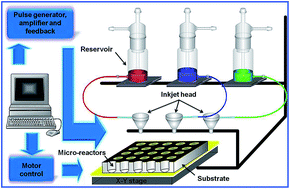Combinatorial discovery of self-color-mixing phosphors Bi4(1−x)Si3O12 : RE4x3+ (RE3+ = Dy3+, Eu3+) for direct white light emission†
Abstract
Phosphors with direct white light emission have been successfully found in the rare earth doped bismuth silicate systems, Bi4(1−x)Si3O12(BSO) : RE4x3+ (RE3+ = Eu3+, Dy3+), using a fast combinatorial design and screening method. The material libraries were synthesized by ink-jetting precursor solutions into microreactor wells and sintering at high temperatures. The candidate compositions of the white light phosphors with varied dopant concentrations were evaluated by screening the recorded luminescence pictures under UV light excitation. The optimal compositions showing white light emission were further confirmed to be Bi3.96Si3O12 : Eu0.043+ and Bi3.84Si3O12 : Dy0.163+ via scale-up experiments. Additionally, the CIE chromaticity coordinate of the white light emission is located at (0.333, 0.326) for the optimal Bi3.96Si3O12 : Eu0.043+ and the CIE coordinate of the Bi3.84Si3O12 : Dy0.163+ phosphor is located at (0.302, 0.333), which are both very close to the CIE coordinate of soft sunlight (0.330, 0.330) and good for human eyesight. For the BSO : RE3+ (RE3+ = Eu3+, Dy3+) samples, the generation of direct white light emission can be realized by properly controlling the amount of doped RE3+ ions. It has been concluded that the white light emission directly results from a self-color-mixing mechanism of intrinsic host luminescence and doping ion luminescence. Besides that, the luminescence properties, energy transfer mechanism, and decay time of the direct white light phosphors have been discussed to set up a close relationship between the doping compositions and luminescence characteristics of the BSO : RE3+ (RE3+ = Eu3+, Dy3+) phosphors.


 Please wait while we load your content...
Please wait while we load your content...